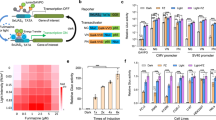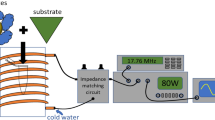Abstract
Means for temporally regulating gene expression and cellular activity are invaluable for elucidating underlying physiological processes and would have therapeutic implications. Here we report the development of a genetically encoded system for remote regulation of gene expression by low-frequency radio waves (RFs) or a magnetic field. Iron oxide nanoparticles are synthesized intracellularly as a GFP-tagged ferritin heavy and light chain fusion. The ferritin nanoparticles associate with a camelid anti-GFP–transient receptor potential vanilloid 1 fusion protein, αGFP-TRPV1, and can transduce noninvasive RF or magnetic fields into channel activation, also showing that TRPV1 can transduce a mechanical stimulus. This, in turn, initiates calcium-dependent transgene expression. In mice with stem cell or viral expression of these genetically encoded components, remote stimulation of insulin transgene expression with RF or a magnet lowers blood glucose. This robust, repeatable method for remote regulation in vivo may ultimately have applications in basic science, technology and therapeutics.
This is a preview of subscription content, access via your institution
Access options
Subscribe to this journal
Receive 12 print issues and online access
$209.00 per year
only $17.42 per issue
Buy this article
- Purchase on Springer Link
- Instant access to full article PDF
Prices may be subject to local taxes which are calculated during checkout





Similar content being viewed by others
Change history
20 February 2015
In the version of this article initially published, the ferritin linker region was incorrectly described as HA-tagged. It was FLAG-tagged. Thus, the descriptions of its detection in the study and of the protocol used for its detection in the Online Methods were incorrect (including an incorrect reference for the associated antibody used). Also, the description of the development of the tag was missing from the Online Methods. The errors have been corrected in the HTML and PDF versions of the article.
References
Davidson, B.L. & Breakefield, X.O. Viral vectors for gene delivery to the nervous system. Nat. Rev. Neurosci. 4, 353–364 (2003).
Ando, H., Furuta, T., Tsien, R.Y. & Okamoto, H. Photo-mediated gene activation using caged RNA/DNA in zebrafish embryos. Nat. Genet. 28, 317–325 (2001).
Cambridge, S.B., Davis, R.L. & Minden, J.S. Drosophila mitotic domain boundaries as cell fate boundaries. Science 277, 825–828 (1997).
Wang, X., Chen, X. & Yang, Y. Spatiotemporal control of gene expression by a light-switchable transgene system. Nat. Methods 9, 266–269 (2012).
Gossen, M. et al. Transcriptional activation by tetracyclines in mammalian cells. Science 268, 1766–1769 (1995).
Danielian, P.S., Muccino, D., Rowitch, D.H., Michael, S.K. & McMahon, A.P. Modification of gene activity in mouse embryos in utero by a tamoxifen-inducible form of Cre recombinase. Curr. Biol. 8, 1323–1326 (1998).
Böcker, R., Estler, C.J., Maywald, M. & Weber, D. Comparison of distribution of doxycycline in mice after oral and intravenous application measured by a high-performance liquid chromatographic method. Arzneimittelforschung 31, 2116–2117 (1981).
Peters, R.W., Shafton, E., Frank, S., Thomas, A.N. & Scheinman, M.M. Radiofrequency-triggered pacemakers: uses and limitations. A long-term study. Ann. Intern. Med. 88, 17–22 (1978).
Stanley, S.A. et al. Radiowave heating of iron oxide nanoparticles can regulate plasma glucose in mice. Science 336, 604–608 (2012).
Huang, H., Delikanli, S., Zeng, H., Ferkey, D.M. & Pralle, A. Remote control of ion channels and neurons through magnetic-field heating of nanoparticles. Nat. Nanotechnol. 5, 602–606 (2010).
Knight, L.C. et al. Binding and internalization of iron oxide nanoparticles targeted to nuclear oncoprotein. J. Mol. Biomark. Diagn. 1, 10000102 (2010).
Iordanova, B., Robison, C.S. & Ahrens, E.T. Design and characterization of a chimeric ferritin with enhanced iron loading and transverse NMR relaxation rate. J. Biol. Inorg. Chem. 15, 957–965 (2010).
Kirchhofer, A. et al. Modulation of protein properties in living cells using nanobodies. Nat. Struct. Mol. Biol. 17, 133–138 (2010).
Hong, L., Peptan, I.A., Colpan, A. & Daw, J.L. Adipose tissue engineering by human adipose-derived stromal cells. Cells Tissues Organs 183, 133–140 (2006).
Durand, J.L., Hosinking, W. & Jelicks, L.A. Time course of effects of inhalation anesthesia on blood glucose level in male and female C57BL/6 mice. Horm. Metab. Res. 41, 339–341 (2009).
Tanaka, K. et al. Mechanisms of impaired glucose tolerance and insulin secretion during isoflurane anesthesia. Anesthesiology 111, 1044–1051 (2009).
Vore, S.J., Aycock, E.D., Veldhuis, J.D. & Butler, P.C. Anesthesia rapidly suppresses insulin pulse mass but enhances the orderliness of insulin secretory process. Am. J. Physiol. Endocrinol. Metab. 281, E93–E99 (2001).
Kawano, T. et al. Biophysical and pharmacological properties of glucagon-like peptide-1 in rats under isoflurane anesthesia. Anesth. Analg. 115, 62–69 (2012).
Fortin, J.P., Gazeau, F. & Wilhelm, C. Intracellular heating of living cells through Néel relaxation of magnetic nanoparticles. Eur. Biophys. J. 37, 223–228 (2008).
Liedtke, W. et al. Vanilloid receptor–related osmotically activated channel (VR-OAC), a candidate vertebrate osmoreceptor. Cell 103, 525–535 (2000).
Gilles, C. et al. Magnetic hysteresis and superantiferromagnetism in ferritin nanoparticles. J. Magn. Magn. Mater. 241, 430–440 (2002).
Johnsen, S. & Lohmann, K.J. The physics and neurobiology of magnetoreception. Nat. Rev. Neurosci. 6, 703–712 (2005).
Arosio, P., Ingrassia, R. & Cavadini, P. Ferritins: a family of molecules for iron storage, antioxidation and more. Biochim. Biophys. Acta 1790, 589–599 (2009).
Kim, T., Moore, D. & Fussenegger, M. Genetically programmed superparamagnetic behavior of mammalian cells. J. Biotechnol. 162, 237–245 (2012).
Beyer, B.K., Stark, K.L., Fantel, A.G. & Juchau, M.R. Biotransformation, estrogenicity, and steroid structure as determinants of dysmorphogenic and generalized embryotoxic effects of steroidal and nonsteroidal estrogens. Toxicol. Appl. Pharmacol. 98, 113–127 (1989).
Saxén, L. Drug-induced teratogenesis in vitro: inhibition of calcification by different tetracyclines. Science 153, 1384–1387 (1966).
Fussenegger, M., Schlatter, S., Datwyler, D., Mazur, X. & Bailey, J.E. Controlled proliferation by multigene metabolic engineering enhances the productivity of Chinese hamster ovary cells. Nat. Biotechnol. 16, 468–472 (1998).
Gadalla, K.K., Bailey, M.E. & Cobb, S.R. MeCP2 and Rett syndrome: reversibility and potential avenues for therapy. Biochem. J. 439, 1–14 (2011).
Samaranayake, H., Wirth, T., Schenkwein, D., Raty, J.K. & Yla-Herttuala, S. Challenges in monoclonal antibody-based therapies. Ann. Med. 41, 322–331 (2009).
Aleman, A. Use of repetitive transcranial magnetic stimulation for treatment in psychiatry. Clin. Psychopharmacol. Neurosci. 11, 53–59 (2013).
Arenkiel, B.R., Klein, M.E., Davison, I.G., Katz, L.C. & Ehlers, M.D. Genetic control of neuronal activity in mice conditionally expressing TRPV1. Nat. Methods 5, 299–302 (2008).
Lauwers, M. et al. An iron-rich organelle in the cuticular plate of avian hair cells. Curr. Biol. 23, 924–929 (2013).
St Pierre, T.G. & Dobson, J. Theoretical evaluation of cell membrane ion channel activation by applied magnetic fields. Eur. Biophys. J. 29, 455–456 (2000).
Kim, T., Moore, D. & Fussenegger, M. Genetically programmed superparamagnetic behavior of mammalian cells. J. Biotechnol. 162, 237–245 (2012).
Hughes, S., McBain, S., Dobson, J. & El Haj, A.J. Selective activation of mechanosensitive ion channels using magnetic particles. J. R. Soc. Interface 5, 855–863 (2008).
Gallego-Sandín, S., Rodriguez-Garcia, A., Alonso, M.T. & Garcia-Sancho, J. The endoplasmic reticulum of dorsal root ganglion neurons contains functional TRPV1 channels. J. Biol. Chem. 284, 32591–32601 (2009).
Toriumi, K. et al. SHATI/NAT8L regulates neurite outgrowth via microtubule stabilization. J. Neurosci. Res. 91, 1525–1532 (2013).
Collins, C.A., Kretzschmar, K. & Watt, F.M. Reprogramming adult dermis to a neonatal state through epidermal activation of β-catenin. Development 138, 5189–5199 (2011).
Heins, N. et al. Emx2 promotes symmetric cell divisions and a multipotential fate in precursors from the cerebral cortex. Mol. Cell. Neurosci. 18, 485–502 (2001).
Acknowledgements
We would like to thank Friedman laboratory members for helpful discussions and S. Korres for assistance with preparation and submission of the manuscript. This work was funded by the Howard Hughes Medical Institute, the JPB Foundation, the US National Institutes of Health (GM095654) and a Rensselaer Fellowship (to J.S.) under a US National Institutes of Health predoctoral training grant (GM067545).
Author information
Authors and Affiliations
Contributions
J.M.F. conceived the project, and J.M.F. and J.S.D. supervised the studies. S.A.S. and J.S. designed and performed the experiments. R.S.K. provided technical advice. S.A.S., J.S., J.S.D. and J.M.F. wrote the manuscript.
Corresponding authors
Ethics declarations
Competing interests
The authors declare no competing financial interests.
Supplementary information
Supplementary Text and Figures
Supplementary Figures 1–10 (PDF 877 kb)
Rights and permissions
About this article
Cite this article
Stanley, S., Sauer, J., Kane, R. et al. Remote regulation of glucose homeostasis in mice using genetically encoded nanoparticles. Nat Med 21, 92–98 (2015). https://doi.org/10.1038/nm.3730
Received:
Accepted:
Published:
Issue Date:
DOI: https://doi.org/10.1038/nm.3730
This article is cited by
-
An electrogenetic interface to program mammalian gene expression by direct current
Nature Metabolism (2023)
-
Acoustic and Magnetic Stimuli-Based Three-Dimensional Cell Culture Platform for Tissue Engineering
Tissue Engineering and Regenerative Medicine (2023)
-
Subsecond multichannel magnetic control of select neural circuits in freely moving flies
Nature Materials (2022)
-
Photothermogenetic inhibition of cancer stemness by near-infrared-light-activatable nanocomplexes
Nature Communications (2020)
-
Reply to: Magneto is ineffective in controlling electrical properties of cerebellar Purkinje cells, Assessing the utility of Magneto to control neuronal excitability in the somatosensory cortex and Revaluation of magnetic properties of Magneto
Nature Neuroscience (2020)



